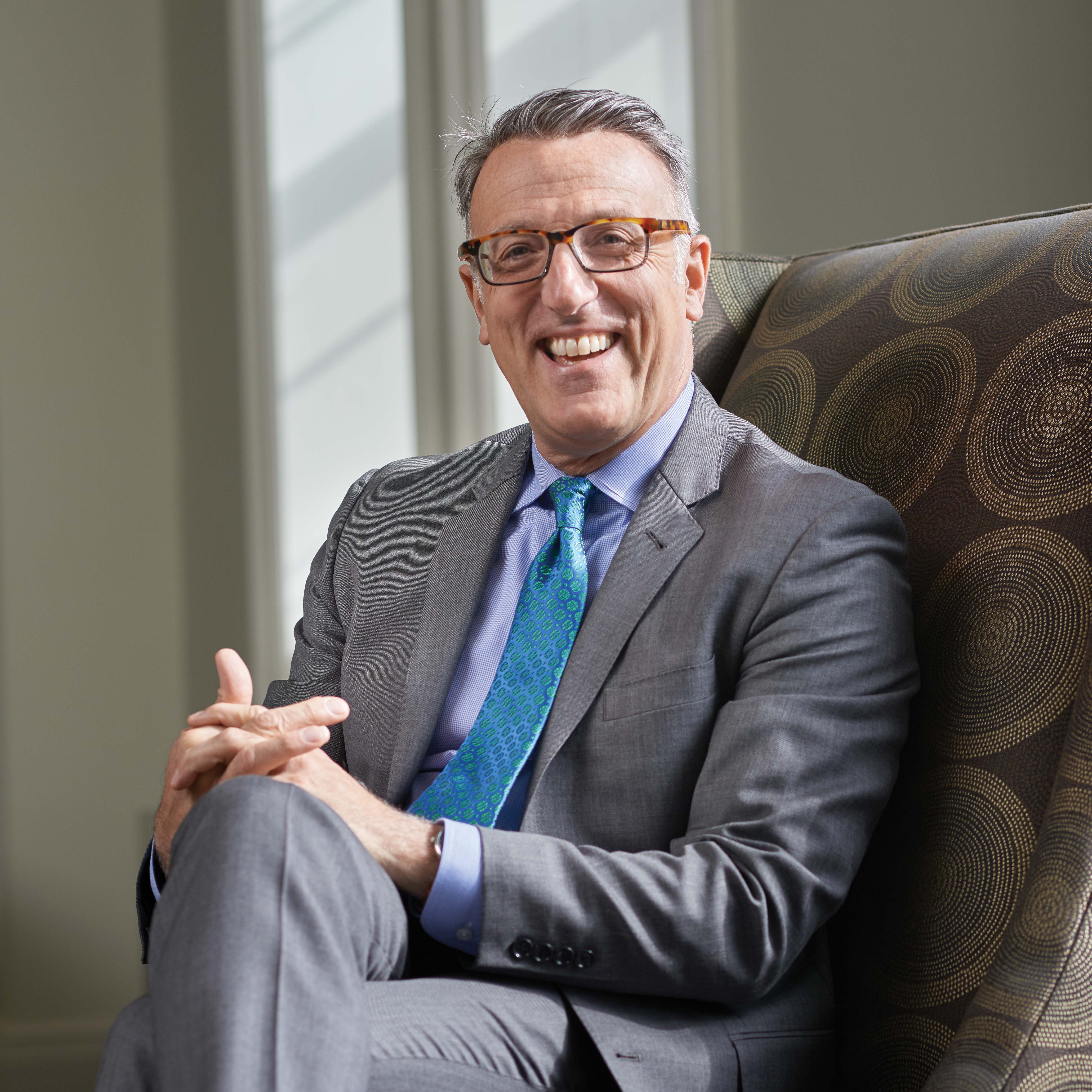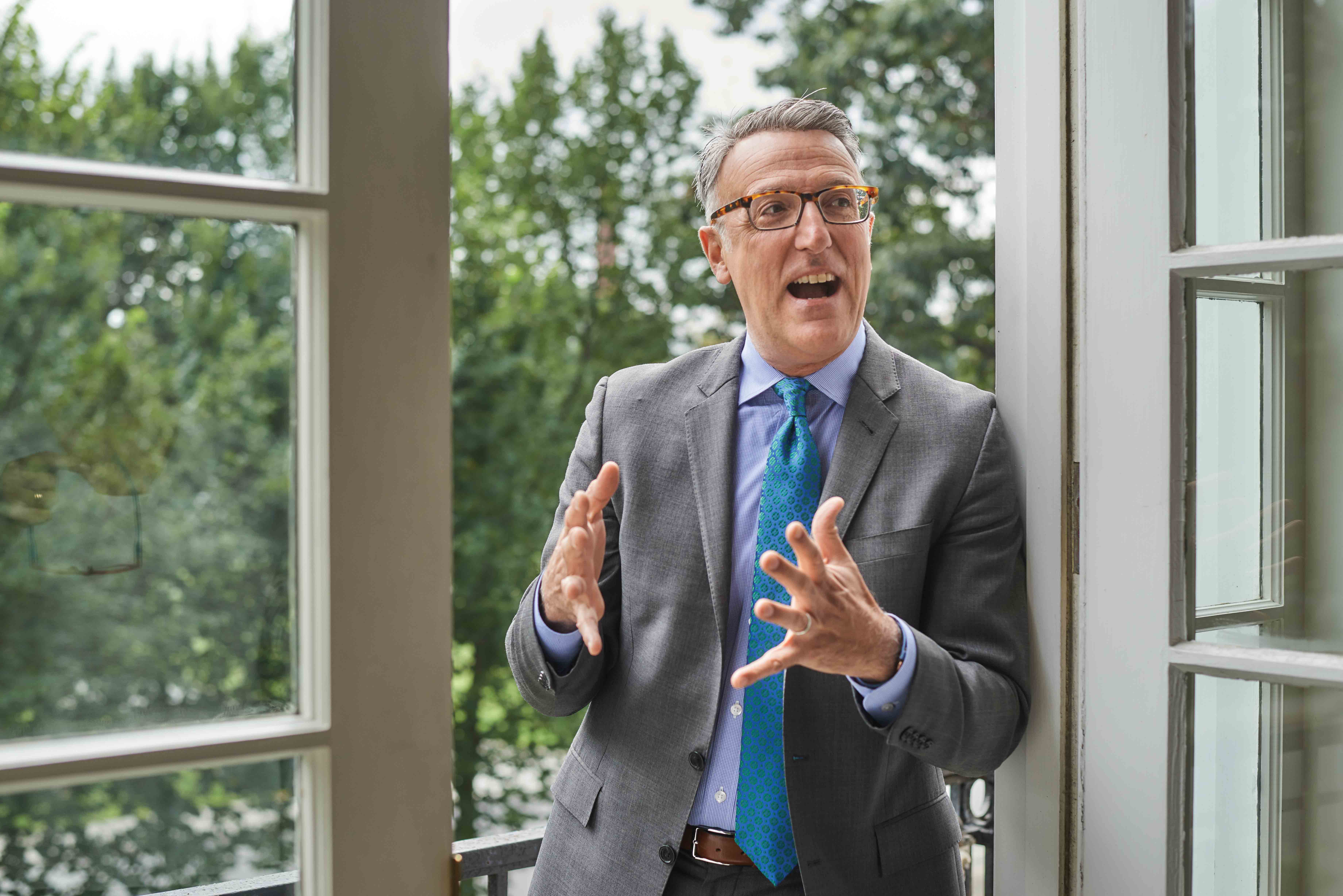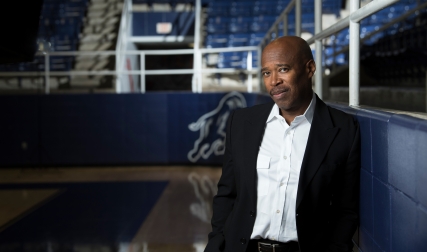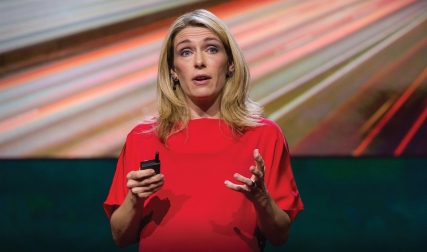What do you look for in an applicant to Dartmouth?
I always look first for academic excellence and potential. That feels like a non-negotiable, but as I’ve asked faculty what they value in their classrooms—beyond the letters and the numbers that define academic excellence—without exception, every faculty member has said, “curiosity.”
How does the admissions process take that variable into account?
What’s always such a challenge in a very selective environment is that admissions data points are so dominant in the public narrative of college admissions. Grade point averages, SAT scores, rank in class—those are the markers that most people recognize as legitimate and credible. The harder question is when you move beyond that set of data. One of the challenges is that there isn’t an easy way to quantify curiosity or creativity or citizenship or all of the things that get lumped into non-cognitive abilities.
One way you did so early in your tenure was by making changes to the essay questions in Dartmouth’s supplement to the Common Application. Can you explain that?
The institutional supplement is a complement to the Common Application. It gives us an institutionally specific way of understanding who each applicant is and to ask whether this person represents the academic and personal values that we share as an institution. If you read the questions we posed to the class of 2021 in the supplement and boil each down to its core elements, we were asking about citizenship and kindness and curiosity and an adventurous spirit—and using one’s intellect to make a difference in the world. The answers we got were often wonderfully different from what we saw just in the Common App.
Can you paraphrase a few of those questions?
First, we asked a question that was required of all applicants, which was essentially, “Why Dartmouth?” And we hadn’t had that question on the application before. Last year’s question channeled Dr. Seuss and “Oh, the places you’ll go” and asked students to think about where they hoped to go in their careers or in their academic journeys and how Dartmouth might help them get there. One memorable response was, “What other Ivy is so wonderfully framed by nature, which makes it an ideal campus for me to study environmental science and apply what I’m learning?” We also included a quote from Henry James about the value of kindness as an essential human quality, and that prompt asked applicants to reflect on a moment when kindness guided their actions—to signal that you can be academically accomplished and intellectually engaged, but also retain that core quality of kindness. Students shared a wide range of examples—from interactions in a classroom to peer-to-peer associations—that helped us imagine the qualities they would add to the campus community.
Why is every applicant required to take the SAT or the ACT?
Those tests give us another data point to look at someone in context. Across this large, talented, increasingly heterogeneous pool, we can have one common element: a test or tests that everybody has taken. In their truest form, those tests provide a forecast of student performance in the first year. What we find when we do validity studies and when we do research based on the first-year performance, more often than not, is that those tests are a signal of someone’s ability to thrive in this curriculum. That said, you have to look at the test in the context of the school, family or community in which the score originates. It is a way of answering, “How have you performed in your local context with the resources available to you?” What some people may see as a low score is sometimes a fantastic score when you consider the applicant’s home, community or high school. In combination with the qualitative data, the teacher recommendations that talk about grit and focus, determination and optimism, as well as the student’s own work and the essays—that’s where it all knits together and you say, “This is someone who’s primed for success.”
“What some people may see as a low score is sometimes a fantastic score when you consider the applicant’s home, community or high school.”
What one piece of advice would you give to a high school senior who’s applying for the class of 2022?
There are two broad categories of information that define every application: the data and then what I call the voice. The data are largely set by the time a student gets to the midpoint in his or her senior fall, but the data piece needs to be accompanied by a clear articulation of the student’s voice. Students should spend some time thinking about the narrative they want to share with the College, answering such questions as “Who am I?” and “Where am I at this point in my life?” and “Where do I think I’m going?” Voice can mean lots of things, but we try to imagine the perspective that a student adds to the classroom or the residential experience or just the broader community, and is this a point of view that’s represented?
What about your advice to a ninth-grader who’s interested in Dartmouth or a similarly selective institution?
My first advice would be to enjoy being 14 and to not let college as an outcome guide and dictate all decisions you make throughout high school. Some people might roll their eyes and say, “That’s naïve to think that you’re going to ignore the end result,” but I think the students who often emerge as most dynamic and appealing to an admission committee are the ones who have an authentic degree of engagement with their pursuits, whether it’s in the classroom or outside of it.
Let’s talk about the first class that you seated, the class of 2021.
I started July 1, 2016. By that point the recruitment cycle for the class of 2021 was well past the halfway point, so my first year was really an opportunity to focus on how we read and select and less on how we tell the story of Dartmouth and think about the pool itself.
You wound up offering admission to about 150 fewer students than the year before.
Yes. And yet, more students than we anticipated—1,279 at the high point—said yes when we offered them admission. At this point, the enrollment stands at 1,217 for a class we had hoped would be 1,150.
Which means you were overenrolled by about 10 percent, at least as of May 1, compared to what you were projecting?
Yes, the historic yield model underestimated this year’s response rate. In addition, we had a lot of success at identifying applicants who understood and responded to our core values. We also asked the faculty to play a more direct role in our admitted-student open houses, and many students who then chose to enroll later told us that access to our professors was a key factor in their decisions. But as matriculation approached, the number organically settled, as it always does, including, as a result, some students choosing to take gap years. We are currently overenrolled by 6 percent [above projected class size] and the class of 2021 should wind up about 70 students larger than the target.

I think the unexpected degree to which it happened was a point of excitement, but it also created a challenge to think about how we preserve the undergraduate experience and honor all the things we value with a cohort that’s bigger.
Where will the College put them?
Part of the strategy was to preserve the integrity of the new house communities and to not disrupt that thoughtful plan, particularly for the first-year student. Some of the upperclassmen have been moved into spaces that had been graduate student housing and the graduate students have been relocated to other, off-campus properties. The incoming class is housed.
You referenced gap years, in which a student might take a year to work, volunteer or travel between high school and college—an
experience some institutions are promoting heavily. How do you advise students who ask you about the wisdom of taking a gap year?
A gap year between high school and college can be a very productive, meaningful opportunity to engage in an activity that provides greater clarity to an undergraduate experience.
In terms of components of a class, can you talk a bit about your objectives and priorities regarding international applicants and how they fit at Dartmouth?
The first meeting I attended as a new Dartmouth employee last year was a meeting about the College’s profile in Asia and how we might enhance it. I think the identity of Dartmouth as a member of the Ivy League and the Ivy League as an internationally recognized symbol of excellence in higher education requires us to be thinking about the College’s profile outside the United States. We have to bear in mind that the class of 2022 will work until the very late 2060s. I often think about how their lives and careers will extend over the middle part of the 21st century. A global institution with a global curriculum parallels the opportunity to have a global student body. I’m not talking about a global student body that dwarfs the rest of the student body, but to have students from other parts of the world represented in our campus community makes sense to me.
In 2015 the College announced it was changing its admissions policy for international students from “need blind” to “need aware,” which meant the decision on an international applicant’s admission could be based, at least in part, on his or her ability to pay. How has that policy, which provoked some backlash, affected applications?
The policy shift from need-blind to need-sensitive admission practices for foreign citizens preceded me. That said, a global representation in the student body is critical, and we achieved a meaningful increase in our international enrollment—from 8 percent in the class of 2020 to 10 percent of this year’s first-year class. Also of note is that more than half of the foreign citizens in the class of 2021 are receiving need-based aid from the College.
What about U.S. students from low-income backgrounds? When The New York Times published data, cited in DAM, showing Dartmouth with the highest percentage of students from households in the top 1 percent by income and the second lowest percentage from the bottom 60 percent for the class of 2013 in the Ivy League, there was criticism from a number of alumni. To what extent has Dartmouth made an effort to increase the percentage of students from low-income backgrounds, including relative to its peers?
The data from that study [which tracked students’ household income from 2009 to 2013] were from the class accepted in 2009, during the recession. In the years since 2009 the College has significantly expanded its recruitment of students from a wider socioeconomic spectrum, as well as students who are first-generation college bound. I would also add that the income data referenced were not an element of Dartmouth’s admissions process as a need-blind institution.
For the class that enrolled this fall, what percentage of students are eligible for federal Pell grants, for which students from households with incomes at or below $50,000 qualify?
In this incoming class, nearly 15 percent are Pell-eligible, which is a record for us. Also, about a third of the foreign citizens we enrolled are from [comparable] low-income backgrounds, none of whom are Pell-eligible but all of whom represent an institutional commitment to low-income access. What’s interesting is if you use only Pell as your definition of low income, you ignore the international students who would be Pell-eligible if they were U.S. citizens. Pell data also exclude any of the undocumented students who are in each class. If you add those two groups to the Pell recipients, Dartmouth’s low-income cohort would rise to about 18 percent of the entering class. The Times has chosen Pell eligibility as its threshold for “low-income access” and “success” in that regard, and I respect that. But if you’re an institution such as Dartmouth that offers need-based aid to foreign citizens, our true low-income cohort is undercounted.

Is one of your own priorities to further increase the percentage of the class from low-income backgrounds?
As with a lot of these topics, my role as dean is not to say, “I think the percentage should be 20 or 25 or 15.” It’s to listen to the community I’m representing and ask, “What’s our collective aspiration here? Do we see an opportunity to push toward a higher low-income enrollment?”
What are you hearing from faculty and administrators?
There’s support for growth in this part of the student body. As we grow, we have to ensure the College’s infrastructure in student affairs evolves as well, so that students coming from very different backgrounds than we’ve normally enrolled can arrive in Hanover and find success. The point isn’t that they’re academically unqualified, the point is they’re coming from schools and families and communities where the resources are different, and the transition from that place to this place might be less smooth than we’re used to.
Are you saying that before you can increase those numbers further, you’ve got to make sure that the academic and non-academic supports are in place here to support those students so that they can be successful and ultimately graduate?
Yes.
In August word leaked from the White House that the U.S. Justice Department will try to rein in affirmative action in selective college admissions. How would Dartmouth respond to such a practice?
Our admissions policy is guided by current law, which allows for the use of race as one factor among many in a holistic admissions process in support of the educational benefits of diversity. We are committed to enrolling a diverse and heterogeneous student body. Affirmative action is a tool to achieve that goal. Any change in the legal framework does not erase that institutional objective.
Has the admission rate among legacy applicants declined recently?
The percentage of the accepted and enrolling class who are the children of Dartmouth undergraduate alumni has remained constant over the last few years. Legacies ultimately make up about 12 to 13 percent of each entering class.
What is your philosophy regarding legacy admissions?
Dartmouth has a remarkable alumni body, in terms of who its alumni are, what they do and their indelible connection to this campus. It’s unprecedented in my career. So legacy candidates are an important constituency in each applicant pool and in the way we think about the class we are shaping. A goal every year is to include as many of these students as we can but, of course, this is a very selective environment and the overall applicant pool is exceptionally talented.
Let’s address cost: At least for students paying the full sticker price, it won’t be too many more years before the full cost of attending Dartmouth will approach $80,000 a year. What efforts are you undertaking in your role to check the growth of that full sticker price?
That mostly falls outside my purview, other than to be a voice in budget meetings around the pressures families face in trying to pay the sticker price, whether it’s subsidized broadly or not. As Dartmouth inches toward and above $70,000 a year, the challenge is to generate the endowment resources to continue to provide access to families for whom $70,000 a year is an unrealistic stretch. One of the things we’ve been modeling this year is a way of looking at the middle-income bands, which I think are the ones that get most squeezed in this conversation. Lower-income families are usually well served by a need-based financial assessment. But in the middle-income bands, where we’re following federal guidelines, there is room to be more elastic as we interpret some of the family assets such as home equity or cost-of-living adjustments. For example, real estate values and the cost of living in places such as California can be significantly more expensive than in other parts of the country.
In closing, can you talk a bit about your family background?
I was a first-generation college student. My dad enrolled in college and dropped out, so he never graduated. He and my mom got married and they had me pretty quickly. He worked for a Buick dealership for most of his career and my mom was a secretary and then stayed home with my siblings and me. I was the oldest of five. I received financial aid and had a work-study job [at Trinity College in Connecticut]. What got me into admissions work almost 30 years ago was my own college search and the lack of guidance I received from my college advisor. In many schools around the country and around the world there are people like me who would benefit from this experience but lack the cultural capital and resources to find their way toward us. I’ve met many alums and faculty who share a similar story. College was the turning point in their lives, and that transformative moment is something that motivates me to do this work at Dartmouth.
Jacques Steinberg was a long-time education reporter for The New York Times and is the author of The Gatekeepers: Inside the Admissions Process of a Premier College (2003). Senior vice president of Say Yes to Education, he lives in Larchmont, New York.
Apply Yourself
To give the admissions office more information about an applicant than can be gleaned from the Common App, Dartmouth’s application form for the class of 2022 includes these writing options.
1) Please respond in 100 words or less.
While arguing a Dartmouth-related case before the U.S. Supreme Court in 1818, Daniel Webster, class of 1801, uttered this memorable line: “It is, Sir…a small college. And yet, there are those who love it!” As you seek admission to the class of 2022, what aspects of the College’s program, community or campus environment attract your interest?
2) Please choose one of the following prompts and respond in 250-300 words.
A. In Love Medicine, author Louise Erdrich ’76 writes, “Society is like this card game here, cousin. We got dealt our hand before we were even born, and as we grow we have to play as best as we can.” Describe your “hand” and reflect on how you have played it.
B. From songs and film to formulae and computer code, human expression and discovery take many forms. How do you express your creativity? What ideas or values do you explore and celebrate when your imagination wanders?
C. During the 2016 Olympic Games, American runner Abbey D’Agostino ’14 collided with another athlete in the first round of the 5,000-meter event. Both fell to the track. Although injured, Abbey’s first instinct was to help the other fallen athlete so they could continue the race together. Their selflessness was widely praised as the embodiment of the Olympic ideal of sportsmanship. Share a moment when kindness guided your actions.
D. Twenty years ago, the world met Harry Potter and his companions. One of the more memorable lines from the J.K. Rowling series was spoken by Albus Dumbledore: “Happiness can be found, even in the darkest of times, if one only remembers to turn on the light.” What ideas or experiences bring you joy?
E. “I have no special talent,” Albert Einstein once observed. “I am only passionately curious.” Celebrate your intellectual curiosity.
F. “Dreams are lovely. But they are just dreams,” television producer Shonda Rhimes ’91 told graduating seniors during her 2014 Commencement address. “It’s hard work that makes things happen. It’s hard work that creates change.” What inspires your hard work? What matters to you and how do you “make things happen” to create change?




